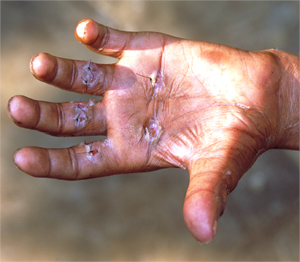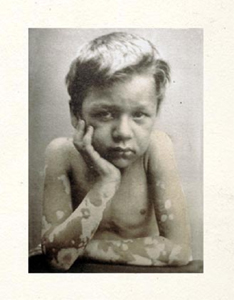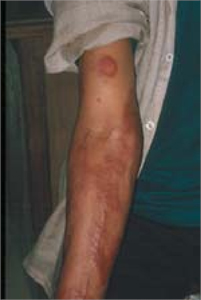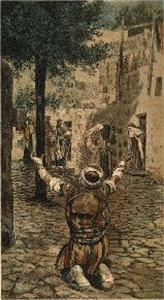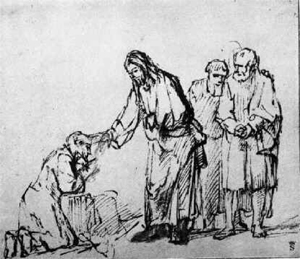
Christmas
Easter
Pentcoest
All Saints
Christ The King
Confirmation
Palm/Passion
Reformation
Stewardship
Books of the Bible
Lenten Series
Christmas Dramas
Videos
Series A - Matthew
Series B - Mark
Series C - Luke
Series D - Other
To contact
Edward F. Markquart
info@sfs.com

Series B Mark 1:40-45 Pastor Edward F. Markquart The following Bible study is from a larger course entitled, THE LIFE OF CHRIST: A Study in the Four Gospels. This 54 week course for the laity will be available for congregations in 2006. Basic text for the course: SYNOPSIS OF THE FOUR GOSPELS, Kurt Aland, English Edition, P. 39-49.
In preparation for a sermon about leprosy, please read the section, "Thoughts about the Healing Miracles of Jesus," in the two previous Gospel Analyses.
Director, Department of Bioregulation, Leprosy Research Center, National Institute of Infectious Diseases, Higashimurayama, Tokyo, JAPAN, norishii@nih.go.jp Abstract Leprosy, also known as Hansen's disease, is a chronic infectious disease that primarily affects the skin, the peripheral nerves, the upper respiratory tract, and the eyes.[1] The causative agent is an acid-fast bacterium, Mycobacterium leprae, first identified in 1873 by the Norwegian physician, Gerhard Henrik Armauer Hansen. Leprosy was considered a divine curse for sin in the Old Testament and a karma in Buddhism. The term leprosy originates from the Latin word lepros, meaning defilement. The fact that leprosy has been deemed an incurable disease, causing severe deformities and disabilities, has resulted in severe stigmatization. This has resulted in double suffering by victims, both from the disease itself and from public discrimination. Although documented since antiquity, leprosy currently remains endemic in some developing parts of the world.[2] In 1991, the World Health Organization (WHO) and its member states committed themselves to eliminate leprosy as a public health problem by the year 2000.[3] Elimination was defined as a prevalence of less than 1 case per 10,000 persons. At the end of the year 2000, the deadline of the program, 597,232 leprosy cases were registered for treatment and 719,330 cases were newly detected in the world.[4] The prevalence rate at the global level was below 1 case per 10,000 persons. Out of the 122 considered endemic in 1985, 107 countries have reached the elimination goal. There have been 690,830 newly detected patients in 2001, 91% of cases detected worldwide live in the top six countries where the disease is most prevalent and endemic (Table 1). The prevalence rate in these top 6 countries has been estimated at 3.9 per 10,000, with a very uneven distribution (Table 1). India accounts for 78% of the cases, and its elimination program is of major importance for global leprosy control. Major target of leprosy control Leprosy, which was endemic in Western Europe in the medieval period, was eliminated from Scandinavian countries only as recently as the early twentieth century, before the advent of antibiotic therapy. Obviously, this decline must be attributed to improvement in living standards, better housing, clean water supplies, and improved nutrition and hygiene. Currently, very few newly registered patients are found in developed countries and, when detected, a significant proportion of them are immigrants from countries where the disease is still endemic. Today, leprosy is found mainly in developing countries, around the subtropical and tropical zone, where the social and economic resources have not been sufficient to support the living standards needed to limit the disease. Current protocols for the diagnosis and treatment of leprosy have been adapted to correspond to the medical standards of developing countries. In this review article, we intend to introduce the protocol for leprosy treatment that was standardized by WHO. (see http://www.who.int/lep/). Diagnosis and classification of leprosy The diagnosis of leprosy is mainly based on the clinical signs and the symptoms of the disease. Most leprosy health workers, with the required, generally short training, can easily observe and recognize these features, although in general, persons with specific complaints would report on their own to the health center. Only in rare instances, there is a need for laboratory and other investigations for diagnosis confirmation. In an endemic country or area, the following cardinal signs should make an individual suspect for leprosy:
The classification of leprosy is based upon 2 basic criteria that are, the clinical manifestations and the results of skin smears. In the classification based on skin smears, patients showing negative smears at all sites are grouped as paucibacillary leprosy (PB), while those showing positive smears at any site are grouped as having multibacillary leprosy (MB). However, skin smear services are not generally available. This made it more practical for most programs to use clinical criteria for classifying and determining the appropriate treatment regimen for individual patients. The clinical classification, for the purpose of treatment, uses the number of skin lesions and nerves involved as the basis for grouping leprosy patients into PB and MB leprosy (Figure 1). In this system, one skin lesion, is designated single (skin) lesion of PB (SLPB). In case of doubt, the patient should be included in MB leprosy. PB and MB classification is useful to differentiate the two forms and to determine the treatment regimen. While classifying leprosy, care should be taken to ensure that patients with one form of the disease are not treated with the regimen of the other form. In case of diagnosis uncertainty, the MDT regimen is advisable. The Ridley-Jopling classification, based upon immunological status of patients to M.Leprae[5], is divided into 2 groups (I group and B group) and 2 types (TT type and LL type). The latter classification is somehow laborious in the identification of patients by both health workers and Dermatologists. #42 THE CLEANSING OF THE LEPER Matthew 8:1-4, Mark 1:40-45, Luke 5:12-16 There are close parallels in the three gospels. -A leper came to him Circle the word, “leper,” and write “Hansen’s Disease” above it. In this particular passage, this kind of leprosy was a skin disease. Technically, it is called “Hansen’s” disease and it is curable. (For further information on Hansen’s disease, see the appendix to this lesson from the World Health Organization.) It was not the kind of distasteful leprosy in which feet, hands and arms deteriorated and were missing. After the cure of this kind of leprosy, the leper went to the priest and obtained a certificate of health as was instructed in Leviticus 13 and 14. The leprosy was a form of psoriasis, a white flaking skin disease. Even so, leprosy was thedreaded disease of Jesus’ day, just as cancer and coronaries are the dreaded diseases of our day. Today, none of us want to hear the “C” word from our doctor about our medical condition. And that’s the way it was in Jesus’ day about leprosy. Nobody wanted to hear the “L” word. Leprosy was highly contagious. It could come in a mild or serious form. It was mild when it involved red or white blotches on the skin; it was serious when it involved the disintegration of toes, ankles and feet, or fingers, wrists and hands. But both forms of leprosy were feared. The way they treated leprosy was to quarantine the infected person. The leper was ostracized from the synagogue and could not participate in Jewish worship. The leper was separated from his mother, father, brother, sister, cousins, friends. Lepers lived in leper colonies. A leper would cover his body with rags, let his hair grow, and no one could come within twelve feet of the leper. Lepers were untouchable; that is, no one could touch a leper in that condition for the leprosy was highly contagious. Leprosy was the dreaded disease of Jesus’ time. His leprosy was thought to have been caused by sin, as were all diseases. Or by demons. http://www.who.int/multimedia/indiaweb/galleryhealth/leprosy/WHO-211179.jpg
http://www.artandmedicine.com/wood/images/Leprosy.jpg
http://www.medi-files.de/pics/artikelbilder/leprosy%20patches.jpg
- begging him, and kneeling he said to him, "If you choose, you can make me clean." Circle the word, “begging.” This is the first encounter in the New Testament with a person who was desperate for healing. The leper was kneeling before Jesus and begging. He was desperate. Like many people, in his century and ours, there was (and still is) a deep hunger for healing. There is a deep hunger that God will heal our disease. We today, and the leper of Jesus’ day, have much in common. This was an ancient prayer and is a daily prayer for anyone who is sick. “Lord, we know that you have the power to heal. You Lord have the power to heal us, to heal me, to heal my loved one, my family member. If you will, you can make them (us) well.” This ancient and contemporary prayer is not prayed in the mood of a demand but a in the mood of a deep and earnest request for healing. As faithful people, we know that God will or will not work a miracle in our lives, and we can live with either consequence. http://home.halden.net/vibeke/tissot/168.jpg
James Tissot, 1886-96 The Leper at Capernaum DISCUSSION QUESTION: TELL OF A TIME WHEN YOU WERE DESPERATE FOR HEALING FOR YOURSELF OR A LOVED ONE? -Moved with pity, Jesus stretched out his hand and touched him, and said to him, "I do choose. Be made clean!" Underline the phrase, “moved with pity.” We discover this compassion in the heart of Jesus many times in the gospels. But this is the only time in the four gospels that we find this phrase, “moved with pity.” We recall that Jesus was “deeply moved again” when he came to the tomb of his close friend, Lazarus. Circle the word, “touched.” In some miracles, Jesus touched a person. In other miracles, Jesus healed from a far distance. Jesus broke the Jewish law and human aversion to touching someone who was seriously ill and thought to be contagious. Jesus touched the contagious man. This speaks volumes about the compassion of Jesus. No one else, in his or her sensible mind, would touch a contagious leper. http://home.halden.net/rolf/merian/m163.jpg
Rembrandt -Immediately the leprosy left him, and he was made clean. Often in these miraculous healing stories, the healing occurs instantly. -After sternly warning him he sent him away at once, saying to him, "See that you say nothing to anyone; but go, show yourself to the priest, and offer for your cleansing what Moses commanded, as a testimony to them." Consistently, Jesus was asking people not to tell about the miraculous healing that occurred. If the word of Jesus’ healing power would spread, many “would be” disciples would become disciples for the wrong reasons. They would become “fair weather disciples,” assuming that Jesus could give them healing for their diseases, food for their hunger, and money for their poverty. People could become followers of Jesus but for the wrong reasons. Similarly, many people were looking for a political messiah like King David, and many people hoped that Jesus would be that political messiah to throw off the yoke of Rome. -But he went out and began to proclaim it freely, and to spread the word, so that Jesus could no longer go into a town openly, but stayed out in the country; and people came to him from every quarter. We hear a historical remembrance: Jesus stayed out in the anonymity of the countryside rather in the population centers of the town. Jesus started becoming a spiritual superstar. Underline the phrase, "he went out and began to proclaim it freely and spread the word (about Jesus)." Jesus shouted the gospel from the housetops, so that the voice of the gospel would echo through the centuries. Like the healed man, we too shout for all people to hear, "The Lord has healed me. The Lord has intervened in my life and made me well." This healed man became the first evangelist. |
